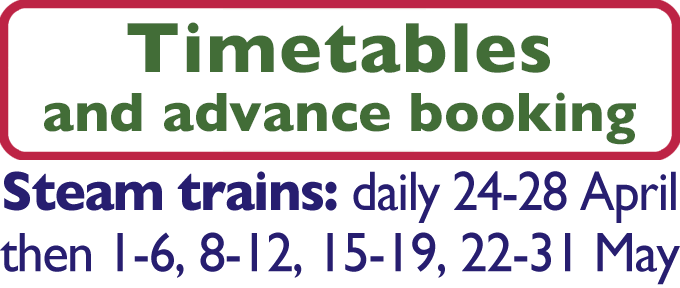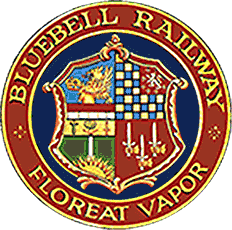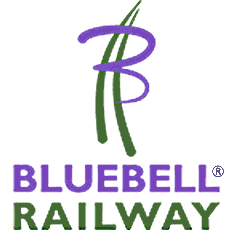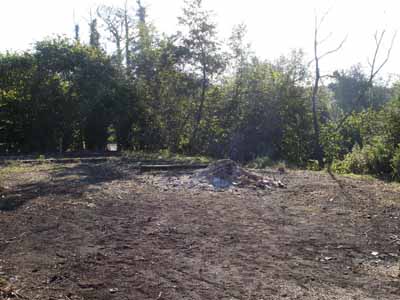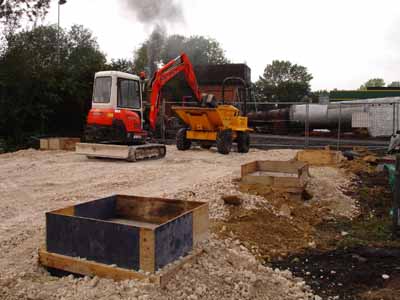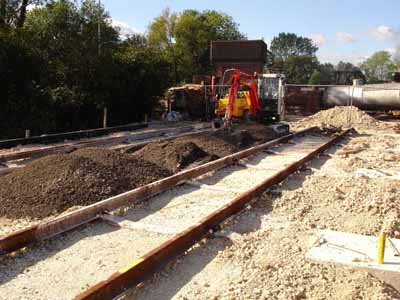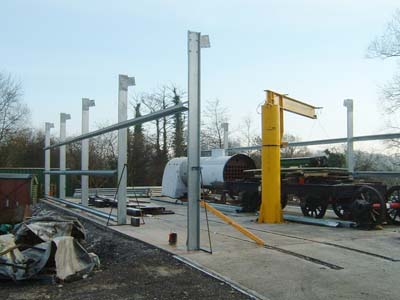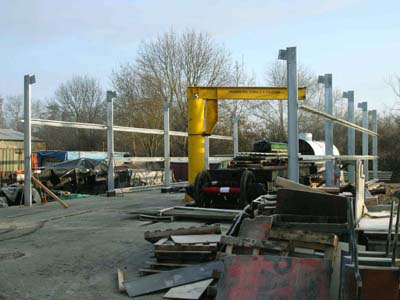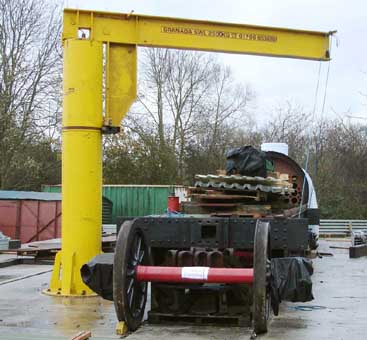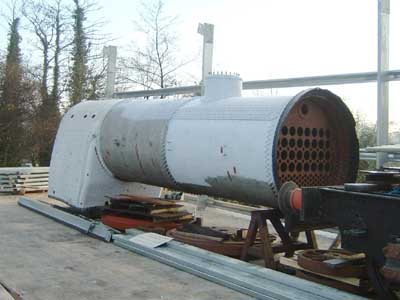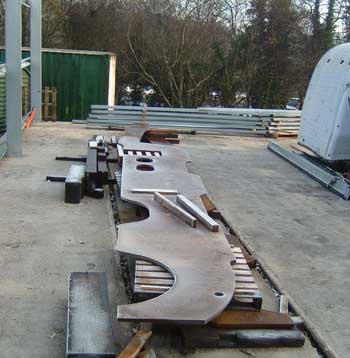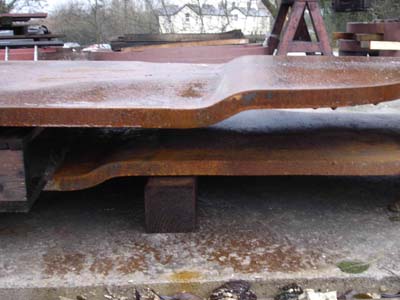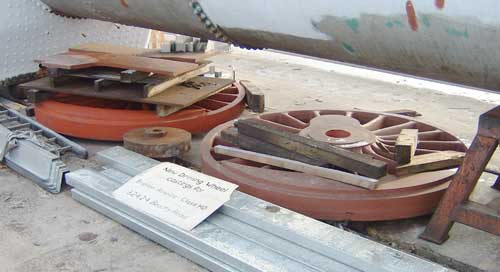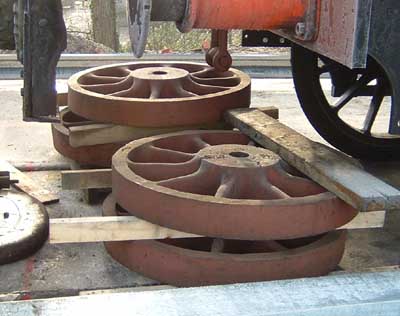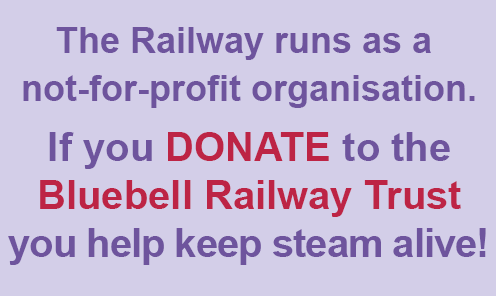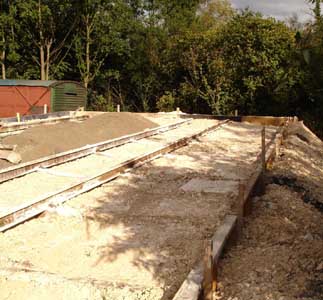
 Much of the spring and summer has been taken up with trying to expedite the construction and with clearing the site. Those who are familiar with the extreme space limitations at Sheffield Park will be aware of the major problems involved in clearing a site of this size from the accumulation of many years storage. I am particularly grateful to Keith for the enormous amount of effort expended in getting the site clear and ready for the contractors.
Much of the spring and summer has been taken up with trying to expedite the construction and with clearing the site. Those who are familiar with the extreme space limitations at Sheffield Park will be aware of the major problems involved in clearing a site of this size from the accumulation of many years storage. I am particularly grateful to Keith for the enormous amount of effort expended in getting the site clear and ready for the contractors.
Now during the autumn we have to try and arrange delivery of the frames (having been joggled by Pridhams at Tavistock) and the crane movement of the boiler and tender onto the base before the building is erected. Although there will be two 'tracks' inside the building it will be vital to get these items in beforehand. Once erection is complete there will be a considerable amount of fitting out to be done including of course the electrics, racks for tools and equipment, a place to store plans drawings and records as well as the installation of a pillar crane we have acquired. When all this is done we will be having an official opening (we expect sometime in the spring) to which sponsors and all regular subscribers will be invited. (More details of this in the next newsletter). This will enable us to better show you what has been achieved so far and how work on the project will proceed.
Keith started working for the project in May nominally for two days a week but the lack of the building has meant that the work has not progressed as quickly as was hoped for. Nevertheless considerable work has been done on remaking the tender axleboxes and 4 were refitted in August and the tender chassis put back on its wheels. A full account of this and other progress appears in Fred's Mechanical Report. Both driving wheel castings are to hand and the modifications to the pattern are now complete so it will be sent to the foundry for casting the coupled wheels next week. The casting of the main wheels has been made possible through the generosity of the late Peter Cox who was an enthusiastic supporter of the project.
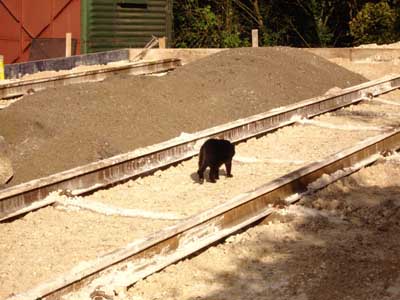 Fred has been extremely busy producing more drawings in particular those for the locomotive axleboxes and main axles. The drawings obtained at York have been a real godsend as although we were unable to find the relevant Atlantic drawings we did obtain motion drawings for the K class and the Baltic tanks. These have proved to be very close in most respects. We are currently exercising our minds on the problems associated with the manufacture and assembly of the wheels on axles with turned tyres. This is going to be a major expense since all the work has to be done at once and none of it can be done `in house'. Indeed there are only a handful of manufacturers capable of undertaking the task. We did obtain a quotation from East Germany just for assembly of the bogie wheels but this was prohibitively expensive. Whilst it may appear that thinking of wheel assembly is premature given that we have yet to erect the frames it is important to realise that all the components relate to one another and each one has to be redrawn or redesigned. So we must think ahead if costly mistakes or abortive effort is to be avoided.
Fred has been extremely busy producing more drawings in particular those for the locomotive axleboxes and main axles. The drawings obtained at York have been a real godsend as although we were unable to find the relevant Atlantic drawings we did obtain motion drawings for the K class and the Baltic tanks. These have proved to be very close in most respects. We are currently exercising our minds on the problems associated with the manufacture and assembly of the wheels on axles with turned tyres. This is going to be a major expense since all the work has to be done at once and none of it can be done `in house'. Indeed there are only a handful of manufacturers capable of undertaking the task. We did obtain a quotation from East Germany just for assembly of the bogie wheels but this was prohibitively expensive. Whilst it may appear that thinking of wheel assembly is premature given that we have yet to erect the frames it is important to realise that all the components relate to one another and each one has to be redrawn or redesigned. So we must think ahead if costly mistakes or abortive effort is to be avoided.
Sponsorship Appeal raises £8000. - A big THANK YOU!
Thanks to your generosity we raised an additional £8000 from the sponsorship appeal in the last newsletter. This is a remarkable effort given the modest size of our subscription base and the fact that most of you are regular contributors. It does however powerfully demonstrate the support for the project and is invaluable in helping secure additional funding.
There are some items remaining on Sponsorship list 1 but we now have a new Sponsorship List 2. Sorry for the delay in producing the Certificates (why does everything take longer thank you think) You should have now received them or if not they will be on their way to you shortly. The lettering on each one is done by hand - we hope you like them.
Finance
As always we are extremely grateful to our donors and regular contributors without whose continued support this project would not make progress. However I make no excuses for reminding you again of the ways in which you can help. All payments made through the Bluebell Railway Trust are worth an extra 28% through Gift Aid.
1. We need more regular contributors to the £5 a month (£15 a quarter) scheme which is so valuable in bringing in regular funds. The numbers are steadily rising - thank you to all new contributors - but we need more. So please go and twist your friends' arms to join and be part of this exciting venture. This is all the more important now we have Keith employed on a regular basis and the expensive part of the operation has begun. A combined Donation, Standing Order and GiftAid form is available.
2. The 'SPONSOR A COMPONENT' scheme which we hope you will be able to support. The idea is that each issue we produce a list of component parts available to be sponsored with their prices. To sponsor a particular item you contact our Treasurer with a cheque made out to the Bluebell Railway Trust (and of course a Gift Aid form if you have not already filled one in). You will receive an attractive Sponsorship Certificate detailing your particular unique item. These will be suitable for framing should you wish. The [second] component list is now available.
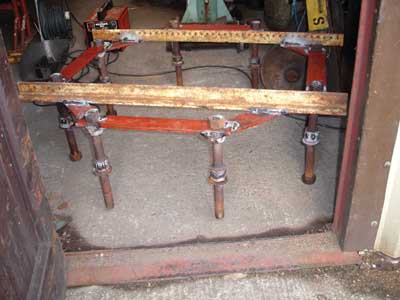 3. Sponsor our building. We still have some 400 sq ft of building available for sponsorship at £30 a sq ft.
3. Sponsor our building. We still have some 400 sq ft of building available for sponsorship at £30 a sq ft.
The photo on the right showns the structure (seen here upside-down) which is being cast into the floor of the new building, and which will support a small crane.
If you wish to leave money to the Atlantic Project (or to Bluebell generally) then this is best done through the Bluebell Trust as this is deducted from your estate before Inheritance Tax calculations are made. Please make your wishes clear in your will.
Contacts
If you have a problem with standing order or other payments and for secretarial, financial, sponsorship or certificate queries please contact David Jones by e-mail or:
3 Nutley Mill Road, Pevensey, East Sussex. BN24 5PD. Tel : 01323 760595
For general project queries, if you have material to donate to the project or wish to help please contact me Terry Cole Tel: 01903 814022
Christmas Cards.
This year's card is of Atlantic 2424 in SR Malachite Green livery at Horsted Keynes heading north in the snow. This is the last in the current series of 4 cards and we have reprinted a small number of the previous 3 cards, so now is your opportunity to complete the set. The cards are available at £10 for 10 including postage. (£9 if you collect) from Matthew Cousins, 1 Sunnycroft Close, Scaynes Hill, West Sussex. RH17 7PT. Tel: 01444 831474 Each pack makes nearly £5 for Atlantic funds.
Please make cheques out to Bluebell Railway PLC.
Atlantic Sales.
My thanks again to Matthew Cousins and Mike Wells for manning the sales stand in the Exhibition Coach at Horsted Keynes. We do need more saleable items, books, models, railwayana, paperwork etc (but no magazines please). These can be given in at Horsted Keynes when the Exhibition van is open or left c/o Keith Sturt at the Loco Works Sheffield Park.
I look forward to be able to give more details of the building's progress next issue and to be able to welcome you to this the Project Headquarters soon. The next Newsletter is due Early 2006.
Edited from text provided by Terry Cole
We have been holding back making a report for some time now hoping to have some notable events to record and no doubt you will have read of these elsewhere.
Keith Sturt has now retired from the post of workshop manager and spends up to two days a week working on the Atlantic Project. Having the input from such a skilled and experienced person as Keith is already making a great difference to the project. Work on the tender is progressing well and soon we will be ready to put the chassis on its wheels. [This has now been done.] This short statement covers quite a lot of work and a range of skills. As we have reported previously, we are reusing two original axleboxes, but we are having to take the remains of those salvaged from the tender that was scrapped after being on exhibition at Windsor behind the replica Dean Single to produce a pair that match our four originals. This has involved the fabrication of new fronts for these boxes. Unfortunately when the Dean single replica was built, the fronts of the original boxes were machined off completely and dummy GWR ones fitted to the remains. We are now making new LB&SCR fronts. The shape of these is quite complex and has involved some very complicated fabrication work. Inside each axlebox is a whitemetalled bronze crown (bearing) that fits between some cast lugs in the axlebox itself. The crown is held in position by a cast iron plate. These latter items had been modified for the GWR replica so we again have rebuilt them so that they can carry out their original function. Two new cast bronze crowns have been machined and white metalled. These will shortly be bedded onto their relevant axle journals by use of hand scrapers. We have still not riveted the new horns in position, but this is only a day or two's work for a three-man team.
In readiness for the new building the boiler has been moved and we took the opportunity to give it a bit of a washout using a pressure washer. A good amount of scale was removed. On further inspection the boiler appears to be in remarkably good order. There are a few marks in the corners of the inner firebox tubeplate that will need a bit of caulking and we will probably take out and replace all the foundation ring rivets. We have not looked in any detail as yet at the stays. On closer inspection however, above the foundation ring in the area where fire irons usually damage the copper plate, we found the original plate numbers stamped in the copper. In fact these were easily legible in all the inner firebox copper plates. This is most unusual and it looks as though during its spell in industry it was not used with a fire in it. Further to this, when we cut the old wasted smokebox off of the boiler there was an external blower valve and shut off valve for the mechanical lubricator atomisers that we saved. This was dismantled and bead blasted. As expected various numbers were found stamped in this component. There were three legible numbers, 3287; 4440 & 3299 plus one questionable that looked like 3363? These are possible engine numbers and in fact all other than the last relate to C1 class large Ivatt Atlantic's. As number 3287 was stamped over 3363 this as in all archaeological dig scenarios is taken to be of a later date than the number underneath. Whilst at York on our last visit I took the opportunity to carry out some research. According to Yeadon's register locomotive number 3287 was fitted with boiler number 9359. (Unfortunately we do not have the boiler number plate, or the Doncaster boiler records that give the plate numbers) From the Doncaster boiler order book this boiler was ordered new in June 1941 under boiler order number 880 (a batch of 5 boilers) and was recorded as fitted to the locomotive on 14/8/1943. This engine was then condemned and withdrawn for scrap on 6/10/1945. We believe that the boiler was put into good order by Doncaster works prior to being sold on to outside industry. These facts if correct may account for the condition of this boiler today. (Locomotive number 3299 was fitted with boiler number 8408 from loco number 4402 on 8/8/1942. It is thought that this boiler would be unlikely to be in such good condition as ours even though withdrawn a little earlier in 1945). Also while at York we obtained copies of any applicable Ivatt large Atlantic drawings. I was hoping to obtain detailed valve gear drawings upon which I could base the ones for our project, but there are very few applicable drawings of any kind for the C1 Atlantic's. We did however get copies of a small number of boiler and firebox drawings that will be useful later on especially when dealing with the boiler insurance company.
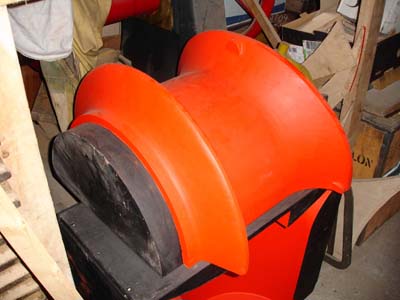 We received the first two wheels cast from our pattern, but were not happy with one of these, so it was returned to the foundry before the pattern was modified to make the coupled wheels. The replacement is good, so the pattern is at present undergoing modification. Our pattern maker, Roy Stirling, has been very productive and we now have a stock of patterns awaiting despatch to the foundry, including the bogie axleboxes, the bogie centre casting, and even one for the chimney. This latter item (Photo: Right) is a real work of art and was produced so soon as I think Roy fancied the challenge. The same chimney pattern with the addition of the capuchon at the top is also suitable for the U class locomotives - so it may prove of use to others as well. I have produced drawings for the new locomotive hornblocks and will soon I hope do the hornstay drawings to match. I hope that one pattern will do both the hornstays for the leaf sprung leading wheels and the coil spring driving wheels with just a change of core box.
We received the first two wheels cast from our pattern, but were not happy with one of these, so it was returned to the foundry before the pattern was modified to make the coupled wheels. The replacement is good, so the pattern is at present undergoing modification. Our pattern maker, Roy Stirling, has been very productive and we now have a stock of patterns awaiting despatch to the foundry, including the bogie axleboxes, the bogie centre casting, and even one for the chimney. This latter item (Photo: Right) is a real work of art and was produced so soon as I think Roy fancied the challenge. The same chimney pattern with the addition of the capuchon at the top is also suitable for the U class locomotives - so it may prove of use to others as well. I have produced drawings for the new locomotive hornblocks and will soon I hope do the hornstay drawings to match. I hope that one pattern will do both the hornstays for the leaf sprung leading wheels and the coil spring driving wheels with just a change of core box.
I believe that since the last report we have also taken delivery of our flat pack "mainframe kit". The mainframes themselves have not been delivered as yet as they are in Devon awaiting the tender mercies of a 700 ton press to put the joggle in. We have not started chasing for delivery of these pieces, as we have not the room at Sheffield Park to store them until our building is completed. Bear in mind they are 34' 4" long about 4' wide and are 1 3/16" thick and weigh about 1.5 tons each. A set of three sturdy trestles has been manufactured from 4" square steel tube to put the frames on when they are delivered. These frame parts have all been cleaned and painted with two coats of red oxide to protect them whilst stored in the open. All the parts shown on the sketch in the last issue are now in stock. The cutting of these parts although done by flame cutting, (not plasma, laser or water jet) has given us a very smooth profile and to an accuracy of about .06" as near as we can judge. There should be no need to machine these other than where it is absolutely necessary. In places where we needed a good accurate face the dimensioning on the drawings gave us a machining allowance after the flame cutting. For the mainframes themselves, we do not propose trying to find a machine big enough to put the frames on, with all the inherent expense that this would entail, but rather to take the machine to the frames. Such things as portable milling machines are available for hire and with careful setting out these may be bolted to the frames in order to machine the sides of the horn gaps for example. As we are in the process of making a unique item we do not have to worry too much in places such as this about exact sizes for interchangeability. We are more concerned with getting the sides of the slots square and parallel to each other to obtain a good fit for the horns that will be machined later to match the slots.
We hope this gives a flavour of the work in progress. Next time we should be installed in the shed!
G. F. Bailey
December 2005
Locomotive main frames arrive. Shed structure starts to rise.
Photos from Fred Bailey and Richard Salmon
